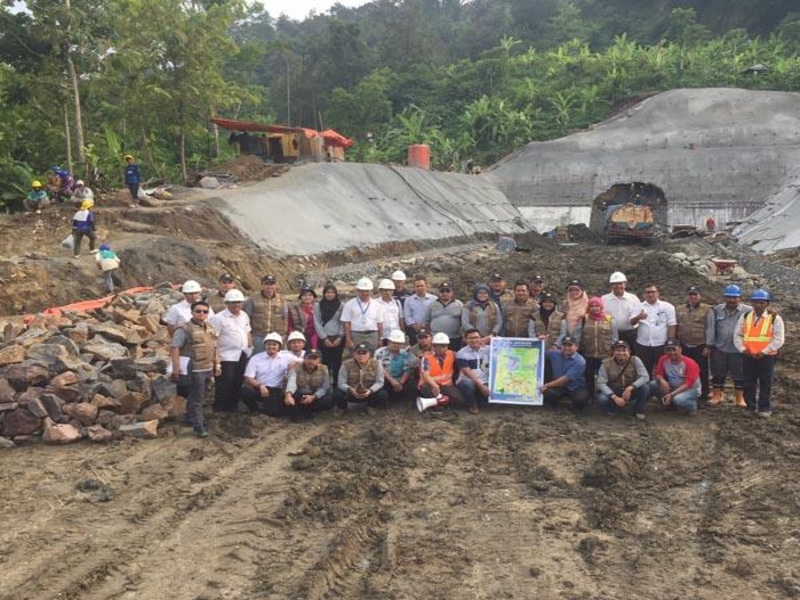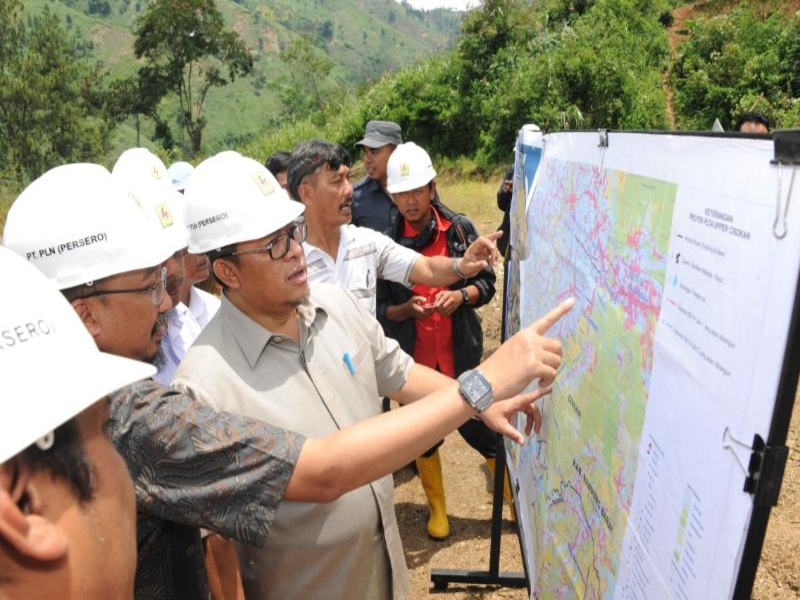The Upper Cisokan hydropower project is a 1GW pumped storage power station under construction in the West Java province of Indonesia. It will be the first pumped storage hydroelectric facility in the country.
Indonesia’s state-owned power company, Perusahaan Listrik Negara (PLN), is developing the project with an estimated investment of £560m ($775m).
PLN awarded contracts for the civil works of the project in the second half of 2015, while the construction was started in the next year, but later delayed due to financial issues.
With the World Bank’s approval of a fresh loan facility in September 2021, the project is now expected for completion and commissioning by 2025.
Project Gallery
-

Indonesia’s state-owned Perusahaan Listrik Negara (PLN) is developing the 1,040MW Upper Cisokan pumped storage hydroelectric power project. Image courtesy of Kementerian Energi dan Sumber Daya Mineral Direktorat Jenderal Energi Baru, Terbarukan dan Konservasi Energi.
-

The Upper Cisokan pumped storage power project is located in the West Java province of Indonesia. Image courtesy of Pemerintah Provinsi Jawa Barat.
-

The Upper Cisokan pumped storage hydroelectric power plant will be equipped with four Francis reversible pump turbine units rated 260MW each. Image courtesy of Pemerintah Provinsi Jawa Barat.
The Upper Cisokan pumped storage (UCPS) hydropower project is intended to help in meeting peak electricity demand and reduce increasing transmission loads on the Java-Bali grid, while facilitating greater renewable energy integration into the grid.
Financing for Indonesia’s first pumped-storage power project
The World Bank approved a £275m ($380m) loan facility for the construction of the Upper Cisokan pumped storage hydroelectric power station in September 2021.
The Asian Infrastructure Investment Bank (AIIB) is also expected to approve up to £180m ($250m) of loan for the UCPS project in the fourth quarter of 2021, while PLN’s own investment in the project is estimated to be £105m ($145m).
Upper Cisokan project development background
PLN launched the Upper Cisokan pumped storage (UCPS) scheme in 2008 after receiving key environmental permits from the government in April 2007.
The World Bank approved a £388m ($640m) loan for the project from the International Bank of Reconstruction and Development (IBRD) in May 2011.
While construction works were started in 2016, the World Bank cancelled £357m ($596m) from the originally approved loan amount due to unsatisfactory implementation progress as well as high environmental risks in May 2017.
Subsequently, changes were made to the project objectives and design, and the Government of West Java Province announced the environmental permit for constructing and operating the 1,040MW pumped storage facility in June 2019.
PLN, in 2021, finalised the environmental and social management plan (ESMP) for the project based on an updated environmental and social assessment (ESIA), which was conducted in compliance with the World Bank standards in 2020.
Upper Cisokan project location and site details
The Upper Cisokan pumped storage hydroelectric power project is located in West Bandung and Cianjur regencies in West Java, Indonesia.
The lower reservoir of the project will be located on the Cisokan River, while the upper reservoir will be located on the Cirumamis River.
The project site lies 126km south-east of Jakarta and approximately 50km away from Bandung, the capital of West Java.
Upper Cisokan dam and reservoir details
The lower reservoir of the project will be created with the construction of a 98m-high roller-compacted concrete (RCC) gravity dam with a 294m-long crest. The lower reservoir will have a maximum surface area of 260ha and an active storage capacity of 63 million cubic metres (Mcm).
The lower dam’s spillway will comprise two radial gates, each 13.5m-high and 10m-wide, and have a normal discharge capacity of 1,220m3/s.
The upper dam of the pumped storage facility will be a 75.5m-high RCC gravity dam on the Cirumamis River with a crest length of 375m. It will create 10Mcm of active water storage capacity with a maximum reservoir surface area of 20ha. The centre overflow spillway of the upper dam will have a normal discharge capacity of 230m3/s.
Upper Cisokan pumped storage power plant make-up
The Upper Cisokan pumped storage hydroelectric power plant will comprise a 156.6m-long, 26m-wide, and 51.15m-high underground powerhouse equipped with four vertical-axis Francis reversible pump turbine units of 260MW capacity each. The turbines will operate at a net water head of 276m.
The facility will consume 1.1GW of surplus electricity from the grid while operating in pumping mode during low electricity demand and generate 1,040MW of electricity by releasing the stored water from the upper reservoir during peak electricity demand.
The Upper Cisokan power project will utilise two circular headrace tunnels measuring 1,217m and 1,158m long and having an inner diameter of 7.4m. The headrace tunnels will be connected to four steel penstocks measuring 475m to 529m in length, with their inner diameter varying between 3.1m and 5.9m.
The project will also include a side intake structure with two steel-wheeled type gates, two surge tanks of 78m and 81m height and 15m inner diameter, and four 5.2m-diameter tailrace tunnels each stretching from 186m to 268m in length.
The UCPS plant will also have a 500kV outdoor air-insulated (AIS) switchyard of the breaker-and-a-half configuration with eight feeders, along with an administration office.
Power evacuation from the Upper Cisokan pumped storage facility
The electricity generated by the Upper Cisokan pumped storage hydroelectric power plant will be evacuated through two double-circuit 500kV lines connecting the Cibinong-Saguling and Tasik-Depok transmission networks of the Java-Bali grid.
The length of two high-voltage power transmission lines being built as part of the project will be 15.5km and 15.9km, respectively.
Contractors involved in the Indonesian hydropower project
Daelim, an engineering and construction company based in South Korea, in a joint venture with Italian construction group Astaldi and Indonesian state-owned construction company Wijaya Karya (Wika), was awarded a contract worth $234m for civil works related to the construction of two dams, powerhouse as well as the water intake and conveyance structures for the Upper Cisokan pumped storage project in October 2015.
Daelim was to lead the joint venture with 40% stake, with Astaldi and Wika holding 30% each.
CONNUSA, a consulting firm based in Jakarta, Indonesia, was engaged in the detailed engineering design phase of the project that included site investigation, environmental impact assessment study, cost estimates, detailed design report, and preparation of bid documents.
NEWJEC, an engineering consulting firm based in Japan, was engaged in pre-feasibility and feasibility studies, detailed engineering and design, as well as other supplementary studies for the project before 2008.
Sinotech, an engineering company based in Taiwan, was hired to provide the dam safety plan for the project in 2013.
Brantas Abipraya and Pembangunan Perumahan (PP), two local companies, were contracted for the construction of roads for the project.
